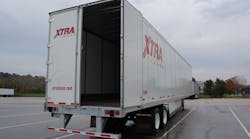While net trailer orders slipped in March compared to previous months, they are up 45% to 50% year-over-year to total 246,000 units for the last twelve months – a trend Don Ake, vice president of commercial vehicles at research firm FTR Transportation Intelligence, described as a “great sign” moving into the seasonally strong second quarter.
Ake noted in a statement that while net trailer orders dipped 20% in March to 20,500 units, the drop off from February for both dry and refrigerated vans is simply due to the start of a “typical” seasonal decline ahead of what’s usually a stronger period for trailer equipment demand.
“The strong year over year comparison reflects a positive trailer order environment,” he added. “Softening backlogs are also consistent with normal market conditions. The OEMs finally started to increase build rates due to the strong orders of the past four months [with] builds jumping an impressive 9% on a per day level over February. Production was basically equal to last March, which is a great sign.”
ACT Research noted that its preliminary estimate for net trailer orders for March hit 21,500 units, adding that commitments “have been delayed this order season” as fleets carefully monitor economic conditions and the political winds to determine their confidence regarding capital expenditures, according to Frank Maly, ACT’s director of CV transportation analysis and research, in a statement.
“Their shift from caution to a more optimistic outlook is evident when you consider net order volumes in each of the last four months has surpassed the same month of the prior year,” he added. “While the 20% decline in net orders from February was a bit more than anticipated, March net orders were up a very solid 45% versus last year. The majority of that strength came from dry vans, which were roughly double last year’s level.”
FTR’s Ake noted that “additional good news” came from vocational trailer segments, with flatbed and dump trailer production up considerably while the tanker trailers segments are moving in the right direction.
“These vocational segments continue to track closely with Class 8 trucks, which are also on the upswing,” he pointed out. “Fleets are growing much more optimistic about the business environment and they are buying more trailers again after a slump the second half of last year.”
However, Michael Baudendistel, vice president of the Stifel Transportation & Logistics Research Group, took a more pragmatic tone where trailer production trends are concerned.
“We do not believe the March orders should change the consensus outlook for 2017 production, especially as we increased our production outlook last month after observing strong January-February data, and the March demand appears relatively in line with recent trends,” he said in a research note.
“Our updated 2017 production estimate of 265,000 units represents an 8% year-over-year decline from 2016 production of 288,000 units,” Baudendistel pointed out. “While that is a steeper decline than orders currently imply, we believe that is a reasonable assumption as production is likely to start the year weak—though we expect strengthening in build rates, in excess of normal seasonality, as the year goes on.”
ACT’s Maly added another wrinkle to his firm’s trailer outlook, noted that the current order cycle differs significantly from past events.
“The order season normally starts strong in late summer/early fall and closes the first quarter at a more moderate pace,” he explained. “This order cycle has proceeded in almost the opposite pattern. In fact, the longer-term perspective shows the total net orders booked from last September through March is now almost equal to the 2015/2016 order cycle volume.”



